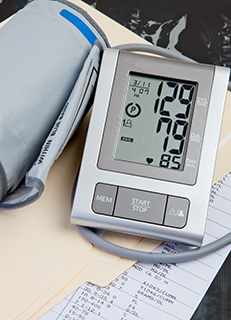Recommended blood pressure targets for diabetes are being challenged

Recommended blood pressure targets for diabetes are being challenged University of Gothenburg
In February 2015, the Swedish National Board of Health and Welfare raised the recommended goal for systolic blood pressure (blood pressure when the heart is contracting) in their guidelines for diabetes care.
The target blood pressure was raised from the previous level of below 130 mm Hg to below 140 mm Hg. The recommended target is important for how intensive antihypertensive treatment should be in patients with diabetes.
Linear relationship
The background for the revised recommendation was research suggesting that not only high blood pressure values, but also values below 130 mm Hg could lead to increased morbidity from cardiovascular diseases.
The researchers behind the new study are questioning this. Their study shows a linear relationship between blood pressure and cardiovascular disease. The lower the blood pressure, the fewer cases of stroke and myocardial infarction, even at the lowest levels.
“We believe that the recommendation to accept higher blood pressure in patients with diabetes is incorrect. It may lead to more cases of stroke and myocardial infarction in this patient group,” said Staffan Björck, Associate Professor of Nephrology at Sahlgrenska Academy, University of Gothenburg and one of the researchers behind the study.
187,000 patients
The new study is based on data from the National Diabetes Register, the Patient Register and the Prescribed Drug Register. It covers 187,000 patients with type 2 diabetes, who were followed for an average of 5 years.
The main difference between this study and the studies on which the Swedish National Board of Health and Welfare based its recommendations is that patients who already suffered from serious diseases were not included in the new study.
“What we have seen in our study is that, if we exclude individuals with previous severe disease, then the connection between low blood pressure and increased risk of stroke and myocardial infarction disappears,” said Samuel Adamsson Eryd, MD, the primary author of the study.
There is a natural explanation for this.
“If patients with diseases that can cause low blood pressure are also included in a study, the overall interpretation might be that low blood pressure leads to more cardiovascular disease,” said Staffan Björck.
300,000 patients in Sweden
There are approximately 300,000 patients with diabetes in Sweden, but they are not the only ones affected by the revised blood pressure targets. Both European and American expert organizations have raised the recommended goal for systolic blood pressure to below 140 mm Hg. As the new study is much larger than all previous studies on the topic, it is important for discussions of blood pressure targets, both in Sweden and abroad.
The study Blood pressure and complications in individuals with type 2 diabetes and no previous cardiovascular disease: national population based cohort study was published in BMJ on August 4.
Link to article: http://www.bmj.com/content/354/bmj.i4070.long
Contact:
Staffan Björck, Associate Professor at Sahlgrenska Academy, University of Gothenburg
staffan.bjorck@vgregion.se
Samuel Adamsson Eryd, researcher at Sahlgrenska Academy, University of Gothenburg
samuel.adamssoneryd@registercentrum.se
http://sahlgrenska.gu.se/english/research/news-events/news-article//recommended-…
Media Contact
All latest news from the category: Health and Medicine
This subject area encompasses research and studies in the field of human medicine.
Among the wide-ranging list of topics covered here are anesthesiology, anatomy, surgery, human genetics, hygiene and environmental medicine, internal medicine, neurology, pharmacology, physiology, urology and dental medicine.
Newest articles

NASA: Mystery of life’s handedness deepens
The mystery of why life uses molecules with specific orientations has deepened with a NASA-funded discovery that RNA — a key molecule thought to have potentially held the instructions for…

What are the effects of historic lithium mining on water quality?
Study reveals low levels of common contaminants but high levels of other elements in waters associated with an abandoned lithium mine. Lithium ore and mining waste from a historic lithium…

Quantum-inspired design boosts efficiency of heat-to-electricity conversion
Rice engineers take unconventional route to improving thermophotovoltaic systems. Researchers at Rice University have found a new way to improve a key element of thermophotovoltaic (TPV) systems, which convert heat…



